Thermistors: NTC and PTC Thermistors Explained
The thermistor is one of many options to measure and detect temperature, from transportation to manufacturing, it is nothing new to utilize a thermistor to collect temperature data! But have you ever wondered what are the different variants of thermistors and their applications? Today we shall answer that question!

Before we can jump right into our main dish today, you are recommended to read these articles on basic concepts related to thermistors:
- Resistors
- Electricity: Current, Voltage
- Circuits
- Voltage Divider
Putting that aside, we can now talk about Thermistors! Let’s look at what will be covered in this article:
- Overview of Thermistors
- NTC vs PTC Thermistors
- Relationships and Calculations
- Applications of Thermistors
- Projects with Thermistors
Overview of Thermistors
What is a Thermistor?
A thermistor is an amalgamation of two words: Thermal and Resistor, which literally makes it a temperature-sensitive resistor! It’s that simple, it is basically a resistor but it’s a special kind of resistors.
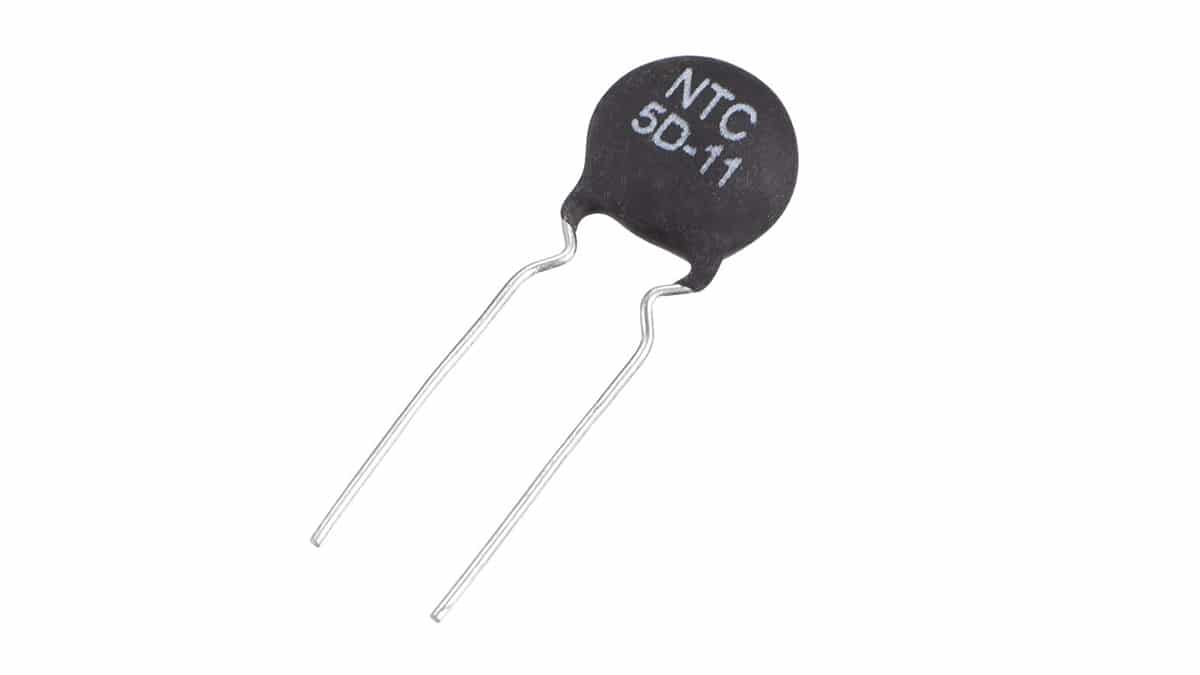
How does Thermistor work?
Just like its name, thermistors are temperature-dependent resistors. Which means it would react to the slightest change in temperature. So how does it react to temperature?
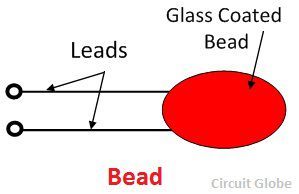
A thermistor is made with a semiconductor and an insulator, where resistance could be found between the insulator and conductor. A sintered mixture of metallic oxides, such as iron, uranium, copper etc is typically chosen, along with an insulator coating the semiconductor. It is available in different forms as well! Usually in the form of bead, disk and rod.
Types of Thermistors
We have listed quite a few types of thermistors here, but NTC and PTC are moer commonly utilised:
Negative Temperature Coefficient (NTC) Thermistor

The NTC is the most commonly used thermistor, especially the 10KΩ NTC thermistor. It is also popular due to its reliability and quick response. Some of the characteristics it possesses are:
- Resistance decreases as temperature increases.
- Resists current to produce heat as the byproduct.
- Correction can be applied to sensed values to maintain accuracy.
- Has a self-heating effect at low temperatures.
Positive Temperature Coefficient (PTC) Thermistor

The PTC has a totally opposite usage than an NTC, though they are not as commonly used, they are usually used for self-regulating heating elements/self-resetting purposes. Some of the characteristics it possesses are:
- Resistance increases as the temperature increases.
- Acts as a throttle in a circuit.
- Exhibits a sudden increase in resistance above a defined temperature.
Thermocouple

Thermocouple is a temperature sensor that has two wires of different metals connected at two points. They also have the widest temperature rang amongst all the temperature sensors!
- Low accuracy: 0.5 °C to 5 °C
- Nonlinear, requires conversion
- Wide temperature range: -200 °C to 1750 °C
- Used as temperature sensors in thermostats, safety device for gas-powered appliances
NTC vs PTC Thermistors
| Thermistors | NTC | PTC |
| Temperature coefficient | Negative (-ve) | Positive (+ve) |
| Metal Oxides | Nickel, iron, manganese, titanium, cobalt | Strontium titanate, barium-, lead- |
| Temperature Range | -55°C to 200°C | 60°C to 120°C |
| Applications | Temperature sensing and control, flow measurement etc. | Over-current protection, self-regulating heater etc. |
Relationships and Calculations
Since we’ve talked about NTC and RTC resistors earlier, let’s look at their relationship using a graph to represent:
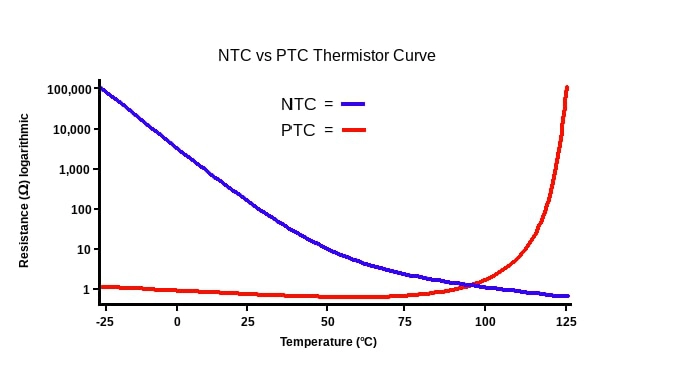
As you can tell from the graph, they have opposing curves which show their temperature coefficient. For NTC, the resistance decreases when the temperature increases. For PTC, the resistance increases when the temperature increases.
Their respective symbols can also be represented this way:
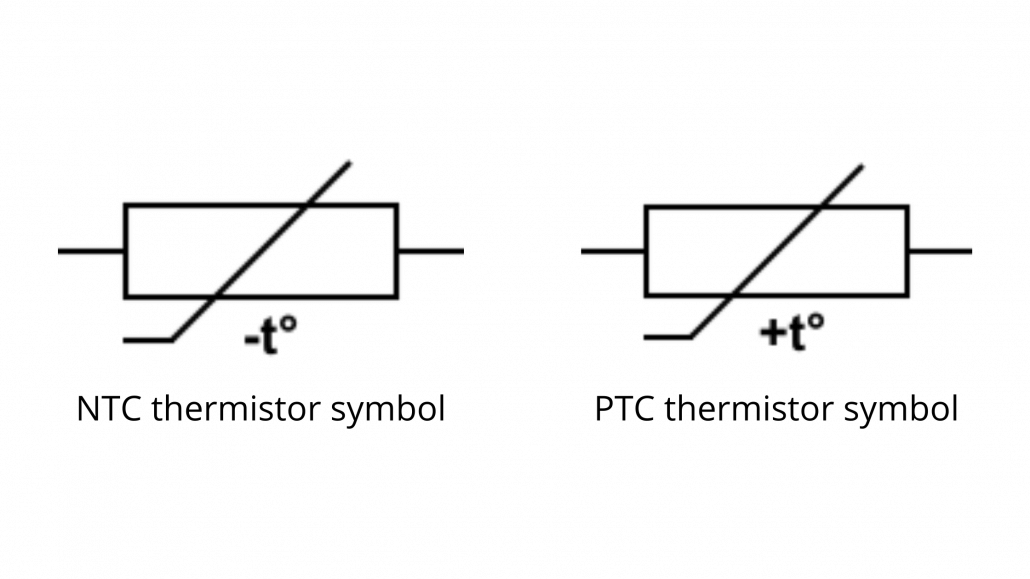
How to measure temperature using a Thermistor?
As we all know till this point, thermistors are resistive devices and a tool to measure temperatures. So how do we go about using it? It’s pretty simple, you can actually use thermistor in a voltage divider circuit!
For instance, if you use a standard 10kΩ thermistor with a series resistor of 10kΩ, the output voltage at the base temperature of 25-degree celsius will be half the supply voltage as 10Ω/(10Ω+10Ω) = 0.5.
Steinhart-Hart Equation
The Steinhart-Hart equation helps to model thermistor temperatures easily and accurately. It was generally used in the past before the existence of computers, nowadays it can be calculated automatically using the software!
The equation is as shown:
Where,
- T1 = First temperature point in Kelvin (SI Unit of Temperature)
- T2 = Second temperature point in Kelvin
- R1 = Resistance of thermistors at T1 in Ohms
- R2 = Resistance of thermistors at T2 in Ohms
To help you understand how to utilise it manually, let’s look at an example!
Question: A 10kΩ NTC thermistor has a B value of 3455 between the temperature range of 25oC and 100oC. Calculate its resistive value at 25-degree celsius and again at 100oC.
Now, the info we have is B = 3455, R1 = 10kΩ at 25-degree celsius. However, we need kelvin instead of degree celsius, so adding 273.15k to the original 25-degree celsius. Slot in all the values and it should look as such:
With the answer, you can then plot a two-point characteristics graph:
Note: Even though only two-points are plotted, but in actual experiments, the more temperature points you plot, the more accurate your reading is going to be!
Applications of Thermistors
Though thermistors are a very specific type of resistors, and mainly helps to regulate temperatures, some of us actually use them every day!
Microwave
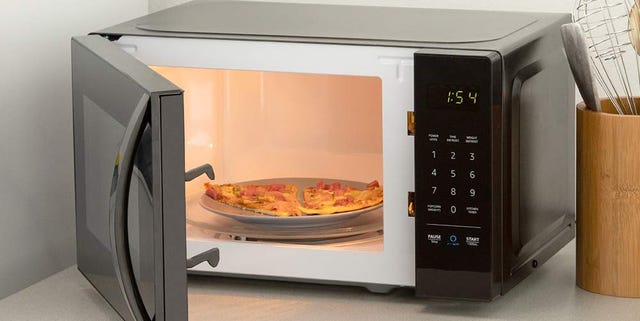
I’m sure this is a very common home applicant and we often use it to reheat overnight or microwavable foods before! Thermistors (or specifically PTCs) are used in microwaves in order to determine and maintain its internal temperature. Without it, overheating may occur and could lead to fire hazards!
Digital Thermometers

Speaking of thermistors, how can you not talk about thermometers? Well, specifically digital ones. The other type of thermometer is mercury thermometers, which uses mercury instead of a thermistor. Digital thermistors use NTCs which measures the temperature and displays the readings accurately!
Projects with Thermistors
Now that we know how thermistors work, we can move on to some fun projects to utilize your thermistors!
Cold Sensor Circuit

Interested in a thermistor circuit to help you monitor the temperature of your fridge? This project would allow you to learn how thermistors monitor the temperature level in a controlled environment, with the help of other electronic components!
What you’ll need:
- NTC Thermistor
- 2 LEDs (Red and yellow)
- Buzzer
- Batteries
- 4 resistors
- Wires
For a more detailed diagram and information, click here!
Make an Arduino Temperature Sensor

If you own an Arduino and would like to wire your thermistor, This basic thermistor tutorial is simple and beginner-friendly! Moreover, the tutorial also includes some of the basic knowledge of thermistors and calculations!
What you’ll need:
- Arduino UNO
- Jumper wires
- LCD RGB Backlight
- Resistor (100k Ohm)
- Single turn potentiometer (100k Ohm)
Sounds interesting? Learn more here!
Summary
And that’s all on thermistors! Did you learn something new? We talked about PTC and NTC thermistors, their relationships and Steinhart-hart equation. Hope that through this article, you’re able to utilise thermistors in your projects!



